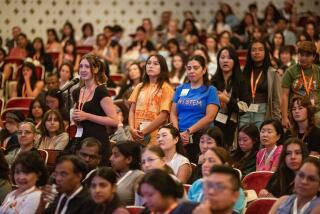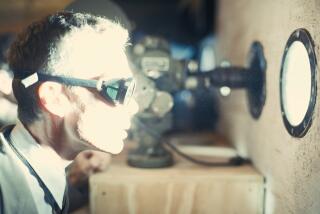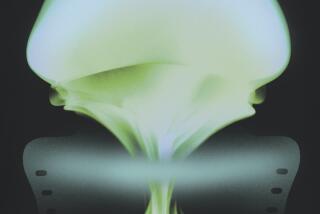Robert Bacher, 99; Caltech Provost, Leader in Crafting 1st Atomic Bomb
Nuclear physicist Robert Bacher, a central figure behind the creation of the atomic bomb during World War II and the first provost of Caltech, died of natural causes Thursday at a retirement community in Montecito. He was 99.
Bacher was one of hundreds of young scientists recruited to Los Alamos, N.M., for the Manhattan Project to build the bomb. He was pulled away from the Massachusetts Institute of Technology in 1943, where he had been conducting radar research, another crucial wartime effort.
Bacher headed the bomb physics division for the project as it reached fruition and put together the first bomb core with his own hands prior to its detonation in the New Mexico desert. Assembly stalled when two parts wedged together incorrectly, but after a few nerve-racking minutes, he dislodged the jam and completed the job.
“Then I got in my government car and drove to the site with [the] bomb in the back seat,” Bacher told the Washington Post years later.
After atomic bombs were used to destroy two Japanese cities, Bacher shared mixed feelings with other members of the project: satisfaction in helping to end a horrific war and remorse at having unleashed so savage a force of technology.
“I knew perfectly well it would be the president, not us at Los Alamos, who would make that decision,” he told the Post. But “it would have been better if [the bomb] somehow could have been used [for] persuasion,” he said. “Good Lord, I certainly feel that!”
After the war, Bacher became a member of the newly formed U.S. Atomic Energy Commission, created to explore military and civilian applications of atomic energy. He also served on the President’s Science Advisory Committee and other top government panels throughout much of the 1950s.
By then, Cold War tensions had created pressure to curtail academic freedom and classify much of the work going on at American universities, said Thomas Tombrello, chairman of the Division of Physics, Mathematics and Astronomy at Caltech, who met Bacher in 1961.
Bacher and a handful of other top advisors argued convincingly that openness would better serve the nation’s economic, security and technological interests.
That advice was largely followed and “was as responsible as anything for the last 50 years of American scientific success,” Tombrello said.
Bacher was born Aug. 31, 1905, in Loudonville, Ohio. He earned his bachelor’s degree in 1926 and his PhD in physics in 1930, both from the University of Michigan.
He taught at Cornell University and conducted research at MIT during the 1930s, collaborating during some of those years with Hans Bethe, who later won a Nobel Prize, on seminal papers in the then-nascent field of nuclear physics.
“We often called those articles ‘the bible of nuclear physics,’ ” said Stanford University physicist Sidney Drell, who encountered Bethe’s and Bacher’s work as a graduate student in 1946.
Bacher joined Caltech’s faculty in 1949. He directed the university’s high-energy physics program, promoting work with an electron synchrotron, one of the first high-energy particle accelerators. That work led to important advances in the field.
Bacher was named Caltech provost in 1962, a position he held until 1970. He also founded Caltech’s radio astronomy program at its Owens Valley Radio Observatory, one of the world’s top facilities of its kind.
His greatest asset as a manager may have been a penchant for recruiting top minds. Among his catches were eventual Nobel Prize winners Richard Feynman and Murray Gell-Mann -- regarded as two of the greatest theoretical physicists in history -- and Robert Christy, another key member of the Los Alamos team.
Bacher’s knack as a talent spotter extended beyond his own field, Tombrello said.
At a cocktail party in 1977, Tombrello’s wife asked Bacher if he had ever met her father, the late sociologist Robert K. Merton, or her brother, who was at the time emerging as a respected economist.
“Young woman, I not only have met them, but once I tried to hire your father and your brother, both at the same time,” Bacher replied.
The brother, Robert C. Merton, went on to win the Nobel Prize in economics in 1997.
Through his ability to recruit, manage and raise money, Bacher fostered the careers of many young scientists.
Alvin Tollestrup, a physicist at the Fermi National Accelerator Laboratory in Illinois who was on the Caltech faculty in 1958, recalled scrambling for funds to buy a collection of photo tubes that cost $500 each -- a princely sum at the time for a young professor.
“Buy the equipment,” he recalled Bacher saying. “Your job is to do the science. It’s my job to get you the money.”
Before World War II, most university research was relatively small scale, and privately funded. With his government connections and savvy for managing large projects, Bacher helped Caltech become a major recipient of government funds from the Office of Naval Research and other agencies. In the process, he helped usher in a new era of large-scale academic science.
“It’s really sad to see the last ones of that generation pass,” Tombrello said, his voice breaking with emotion. “It’s a group of people who changed the world.”
Bacher is survived by a son, Andrew Dow Bacher of Bloomington, Ind.; a daughter, Martha Bacher Eaton of Santa Barbara; and two grandchildren. His wife, Jean Dow, whom he married in 1930, died in 1994.
The family has not announced memorial arrangements.
More to Read
Sign up for Essential California
The most important California stories and recommendations in your inbox every morning.
You may occasionally receive promotional content from the Los Angeles Times.










